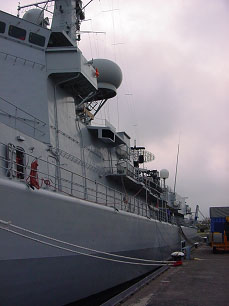In this story we look closely at such an example in practice, namely the test conversion carried out for the Dutch Navy by the Stork Bronswerk Company. This conversion was done on a frigate which lay in the shipyard in Den Helder. Specifically for this conversion the limited space under the ship posed many logistic problems.
Moreover the circumstances were different, such as varying cooling requirements and variations in sea water temperatures, circumstances which ensured problems at different measurements.
The measured decrease of the cooling capacity, corrected to the reference value, with the fluid R-422D with respect to R-22 depends on the score on the capacity drawer. At high regulator output the decrease only differs by a slight percentage where a decrease of 10% was expected.
At partial charge < 70% the decrease appears to amount to a decrease of up to 10% to 20% which is higher than expected. The measured cooling capacity with R-22 corrected to reference design conditions amount to 459 kW. Measurements on the test position of the cold water maker in Amersfoort show cool values of 550 kW which is in accordance with the design data. The measured difference of approx. 90 kW (approx. 16% difference) is too large to be attributed only to measuring errors and other uncertainties. The cause can be due to too low compressed gas and oil temperatures which can lead to a poorer discharge rate of the oil separator. An increased oil circulation generally leads to the reduction in capacity of a system.
.
In order to achieve a better comparison, it is recommended that additional measurements are taken with a well functioning sea water and oil control valve. Furthermore, arrangements must be made to be able to measure the gathered flow of the driving motor.
The abovementioned test case shows that reconversions must be carried out with precaution and that measurements before, during and after the work is essential.

